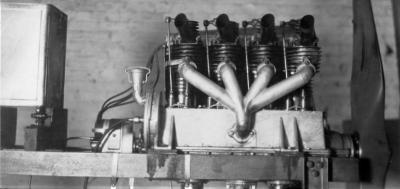 |
| Heath Cannon Ball, 1930 |
 |
| Edition I Engine |
 |
| Edition II Engine, as Received by Grimes |
|
Edward Bavard (Ed) Heath was born in 1888, grew up around his family’s machine shop, and built his first airplane and engine in 1909. Heath formed the Heath Aerial Vehicle Co. in 1910, which he renamed the Heath Aircraft Co. Inc. in 1912; both companies were located in Chicago, Illinois. Heath was a prolific designer and promoter who sold complete aircraft, aircraft kits, parts kits and supplies to people wanting their own low-cost airplanes. His company also ran a flying school and aircraft mechanic school.
In preparation for the 1930 National Air Races, Heath enlarged his popular Baby Bullet sport plane design, turning it into a pure racer. This new aircraft, the Cannon Ball, was powered by a 110 hp engine of Heath’s own design. Heath flew the Cannon Ball to first place in the 1930 National Air Races 275 in³ Class.
Heath made two engines. The first had single ignition and a funny intake manifold; it didn't run very well. Heath took it apart, changed the cylinder heads, intake manifold, accessory case and probably a couple of other things, which made Edition II. Edition I no longer exists except for the parts used in Edition II.
Heath was killed in a 1931 crash, and his Cannon Ball was modified in 1932 to accept a 120 hp Martin 333 engine. The Cannon Ball was destroyed in a 1934 crash. The Edition II engine vanished into obscurity.
A collector and Ed Heath fan who owns several Heath-designed aircraft is building a Cannon Ball racer replica. He found the Edition II Cannon Ball engines in North Carolina several years ago. Although records suggest that Heath only put about 17 hours on the engine, the North Carolina engine was well worn; it may have been used to power an airboat. The engine had a non-standard propeller hub that included a sheet metal shim so it fit the crankshaft taper!
The collector engaged Mike Grimes, owner of Hi Desert Aircraft Repair, to restore the engine. This article chronicles that restoration process. There was no documentation whatsoever with this engine, so Grimes and crew had to figure it all out.
|

